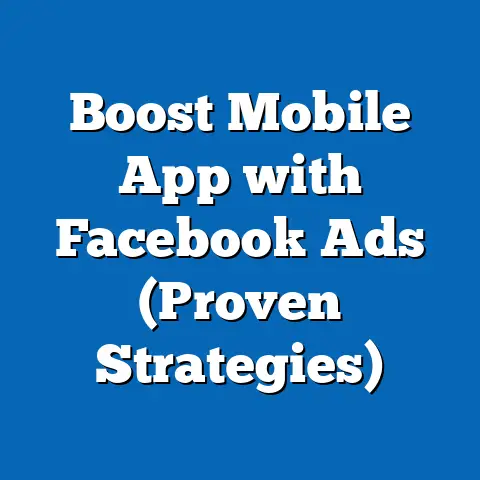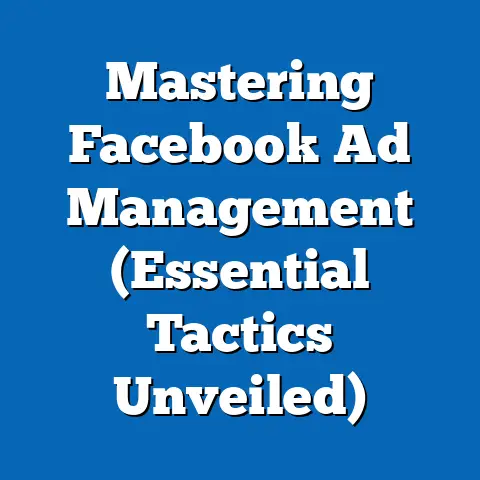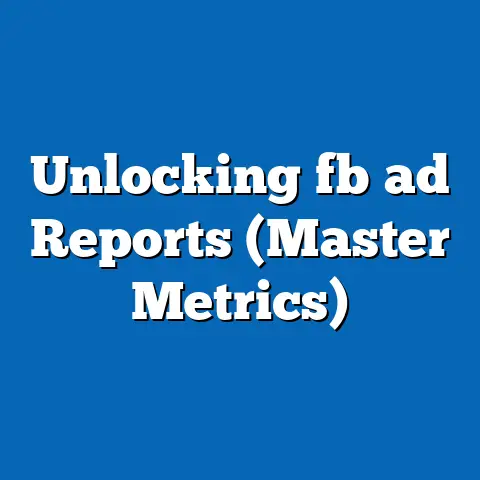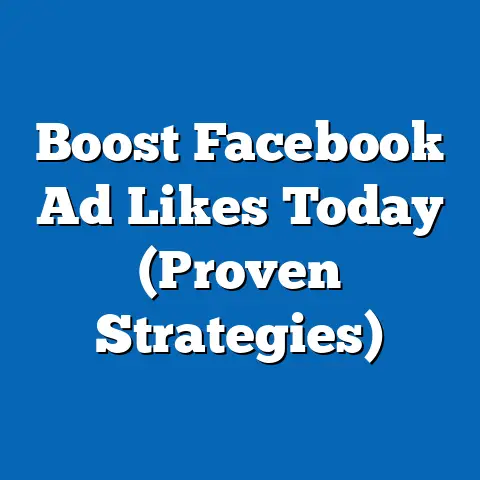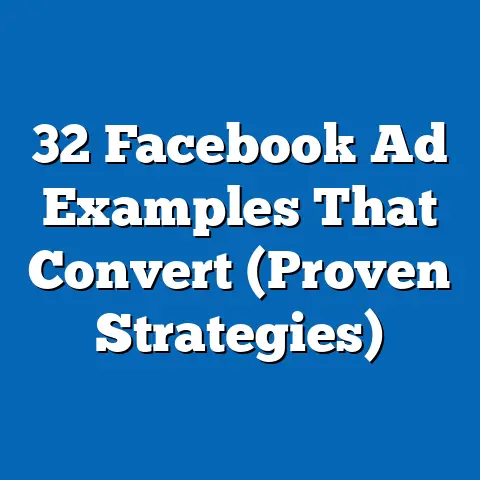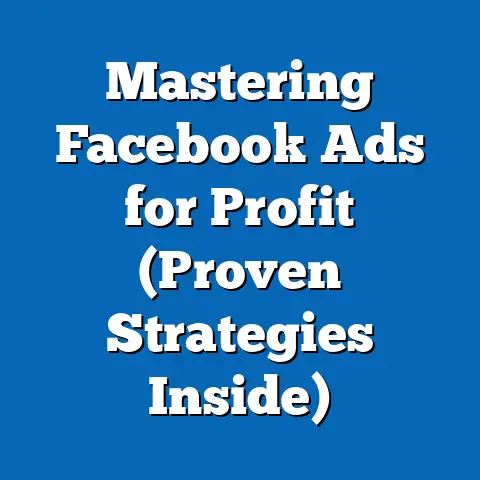Maximize Sales with Facebook Wish Ads (Insightful Strategies)
The world is changing, and so are consumers. We’re seeing a massive shift towards eco-conscious consumerism. People are increasingly seeking out sustainable and environmentally friendly products, and they’re willing to pay a premium for them. This isn’t just a trend; it’s a fundamental shift in values, and brands that ignore it do so at their peril. As someone who has been working in digital marketing for over a decade, I’ve seen countless trends come and go, but this one feels different. It’s not a fad; it’s a genuine desire for a better, more sustainable future.
That’s where Facebook Wish Ads come in. They’re not just another advertising format; they’re a powerful tool for reaching these eco-conscious audiences. I’ve personally seen how Wish Ads, when used strategically, can significantly boost sales and build lasting relationships with customers who share your values. This article will explore insightful strategies to maximize sales through Facebook Wish Ads, particularly focusing on how they can be used to promote eco-friendly products and services. We’ll dive into everything from understanding Wish Ads to crafting compelling creative and analyzing performance. Let’s get started and unlock the potential of Wish Ads for your eco-conscious brand.
Understanding Facebook Wish Ads
Let’s start with the basics. What exactly are Facebook Wish Ads, and how do they differ from the traditional Facebook ads we’re all familiar with?
Wish Ads, in essence, are a specific type of ad format on Facebook designed to create a more interactive and engaging experience for users. Think of them as a more personalized and visually appealing way to showcase your products or services. Instead of just showing a static image or video, Wish Ads often incorporate features like quizzes, polls, or interactive product showcases that encourage users to actively participate.
Key Differences from Traditional Facebook Ads
The biggest difference lies in the level of engagement. Traditional Facebook ads are often passive; users scroll through their feed and may or may not stop to look at your ad. Wish Ads, on the other hand, are designed to grab attention and invite interaction. They’re more like a mini-experience within the Facebook feed.
Another key difference is the focus on visual appeal. Wish Ads typically utilize high-quality images or videos that are specifically designed to capture attention and showcase the product or service in an attractive way. They often feature lifestyle imagery that connects with the target audience on an emotional level.
Unique Features of Wish Ads
- Visual Appeal: Wish Ads are inherently more visually engaging than standard ads. They often use high-quality imagery, videos, or even interactive 360-degree views to showcase products in a captivating way.
- Interactive Nature: This is where Wish Ads truly shine. They incorporate interactive elements like quizzes, polls, or product selectors that encourage users to actively participate. This not only grabs attention but also provides valuable data about user preferences.
- User-Generated Content Integration: One of the most powerful aspects of Wish Ads is the ability to integrate user-generated content (UGC). Featuring photos or videos from your customers using your products can significantly enhance trust and credibility. People are more likely to trust the opinions of other customers than they are to trust advertising claims.
- Personalization: Wish Ads can be highly personalized based on user data and preferences. This allows you to deliver targeted messages that resonate with specific segments of your audience.
The Effectiveness of Wish Ads: Statistics and Case Studies
While Wish Ads are a relatively newer format compared to traditional Facebook ads, the initial results are promising. Early adopters have reported significant improvements in engagement rates, click-through rates (CTR), and conversion rates.
While specific, publicly available statistics on Wish Ads performance are still emerging, the general trend towards interactive advertising is well-documented. For example, studies have shown that interactive content can generate twice as much engagement as static content. Given the interactive nature of Wish Ads, it’s reasonable to expect similar results.
Takeaway: Facebook Wish Ads are a powerful tool for creating engaging and interactive ad experiences. Their visual appeal, interactive features, and potential for personalization make them a great option for brands looking to stand out in the crowded Facebook newsfeed.
Aligning Your Brand with Eco-Conscious Values
In today’s market, simply having a great product isn’t enough. Consumers, particularly eco-conscious ones, are increasingly scrutinizing the values and practices of the brands they support. They want to know that the companies they’re buying from are aligned with their own beliefs about sustainability, ethics, and social responsibility.
As someone who has worked with numerous brands over the years, I can tell you that authenticity is key. Consumers can spot a fake a mile away. If you’re not genuinely committed to eco-conscious values, your marketing efforts will likely backfire.
Why Brand Alignment Matters
- Builds Trust and Loyalty: Eco-conscious consumers are more likely to trust and remain loyal to brands that share their values. They see their purchases as a way to support companies that are making a positive impact on the world.
- Enhances Brand Reputation: A strong commitment to sustainability can significantly enhance your brand’s reputation and attract new customers.
- Differentiates You from Competitors: In a crowded marketplace, aligning with eco-conscious values can help you stand out from the competition and attract customers who are looking for sustainable alternatives.
- Increases Sales and Revenue: Studies have shown that consumers are willing to pay a premium for products and services from companies that are committed to sustainability.
Strategies for Showcasing Your Commitment to Sustainability
- Use Eco-Friendly Materials: If possible, use recycled, renewable, or biodegradable materials in your products and packaging.
- Ethical Sourcing: Ensure that your supply chain is ethical and that your suppliers are committed to fair labor practices and environmental sustainability.
- Transparent Supply Chains: Be transparent about your supply chain and provide information about where your products come from and how they are made.
- Reduce Your Carbon Footprint: Take steps to reduce your carbon footprint, such as using renewable energy, reducing waste, and offsetting your emissions.
- Support Environmental Causes: Donate to environmental charities or partner with organizations that are working to protect the planet.
- Communicate Your Efforts: Don’t be afraid to talk about your sustainability efforts in your marketing materials and on your website. Share stories about your commitment to the environment and highlight the positive impact you’re making.
Incorporating Storytelling in Wish Ads
Storytelling is a powerful tool for connecting emotionally with consumers who prioritize sustainability. Use your Wish Ads to tell stories about your commitment to the environment, your ethical sourcing practices, or the positive impact your products are having on the world.
For example, you could create a Wish Ad that features a video of your employees planting trees, cleaning up beaches, or working with local communities. You could also share stories about your customers who are using your products to live more sustainable lifestyles.
Takeaway: Aligning your brand with eco-conscious values is essential for attracting and retaining customers in today’s market. By showcasing your commitment to sustainability and incorporating storytelling in your Wish Ads, you can connect emotionally with consumers and build a loyal customer base.
Targeting the Right Audience
You can have the most amazing, eco-friendly product and the most compelling Wish Ads, but if you’re not targeting the right audience, your efforts will be wasted. Fortunately, Facebook’s ad platform offers incredibly granular targeting capabilities that allow you to reach specific segments of your audience with laser-like precision.
In my experience, many businesses make the mistake of casting too wide a net. They think that by targeting everyone, they’ll reach more potential customers. However, this approach is often inefficient and expensive. It’s much more effective to focus on targeting the specific audience that is most likely to be interested in your product or service.
Leveraging Facebook’s Targeting Capabilities
Facebook offers a wide range of targeting options that you can use to identify and segment eco-conscious consumers. These include:
- Demographics: You can target users based on their age, gender, location, education level, and other demographic information.
- Interests: You can target users based on their interests, such as environmentalism, sustainability, organic food, and ethical fashion.
- Behaviors: You can target users based on their online behavior, such as their purchasing habits, website visits, and engagement with environmental content.
- Custom Audiences: You can create custom audiences by uploading your own customer data or by targeting users who have interacted with your website or Facebook page.
- Lookalike Audiences: You can create lookalike audiences by targeting users who share similar characteristics with your existing customers.
Identifying and Segmenting Eco-Conscious Consumers
To effectively target eco-conscious consumers, you need to understand their values, behaviors, and motivations. Here are some tips for identifying and segmenting this audience:
- Research Your Target Market: Conduct research to understand the specific needs and preferences of eco-conscious consumers. What are they looking for in a sustainable product? What are their biggest concerns about the environment?
- Use Facebook Audience Insights: Facebook Audience Insights is a powerful tool that allows you to learn more about your target audience, including their demographics, interests, behaviors, and purchasing habits.
- Analyze Your Existing Customer Data: Look at your existing customer data to identify patterns and trends. What are the common characteristics of your eco-conscious customers? What products are they buying? What content are they engaging with?
- Create Buyer Personas: Develop detailed buyer personas that represent your ideal eco-conscious customer. This will help you to better understand their needs and motivations and to create more targeted and effective advertising campaigns.
Creating Buyer Personas
A buyer persona is a semi-fictional representation of your ideal customer. It’s based on research and data about your existing customers and target market. Creating buyer personas can help you to better understand your audience and to create more targeted and effective marketing campaigns.
When creating buyer personas for eco-conscious consumers, be sure to include information about their:
- Values: What are their core values? What do they care about most?
- Behaviors: How do they behave online and offline? What products do they buy? What content do they engage with?
- Motivations: What motivates them to buy sustainable products? What are their biggest concerns about the environment?
- Demographics: What is their age, gender, location, education level, and income?
Takeaway: Targeting the right audience is essential for the success of your Facebook Wish Ads campaigns. By leveraging Facebook’s targeting capabilities and creating detailed buyer personas, you can reach the specific segment of your audience that is most likely to be interested in your eco-friendly products or services.
Crafting Compelling Creative for Wish Ads
Even with the best targeting in the world, your ads will fall flat if the creative isn’t compelling. In the world of Facebook advertising, you have mere seconds to capture someone’s attention as they’re scrolling through their feed. That’s why it’s crucial to create ads that are visually stunning, engaging, and relevant to your target audience.
Over the years, I’ve learned that effective Facebook ads are a combination of art and science. You need to understand the principles of good design and copywriting, but you also need to be data-driven and constantly testing and optimizing your ads.
Key Elements of High-Performing Wish Ads
- Visuals: The visuals are the first thing that people will see, so they need to be eye-catching and relevant to your product or service. Use high-quality images or videos that showcase your product in an attractive way.
- Copy: The copy should be clear, concise, and persuasive. Highlight the benefits of your product or service and explain why it’s the best choice for eco-conscious consumers.
- Call-to-Action (CTA): The CTA should be clear and direct. Tell people what you want them to do, whether it’s to visit your website, make a purchase, or learn more about your product.
Creating Visually Stunning Ads
- Use High-Quality Images and Videos: Avoid using blurry or pixelated images. Invest in professional photography or videography to create visuals that are both attractive and informative.
- Showcase Your Product in Action: Instead of just showing a static image of your product, show it being used in a real-world setting. This will help people to visualize themselves using your product and to understand its benefits.
- Use Lifestyle Imagery: Incorporate lifestyle imagery that connects with your target audience on an emotional level. Show people who are living sustainable lifestyles and using your products to make a positive impact on the world.
- Use Bright Colors and Bold Typography: Use colors and typography that are eye-catching and that reflect your brand’s personality.
Writing Persuasive Copy
- Highlight the Benefits: Focus on the benefits of your product or service, rather than just the features. Explain how your product can help eco-conscious consumers to live more sustainable lifestyles, save money, or make a positive impact on the world.
- Use Strong Verbs and Action Words: Use verbs and action words that are persuasive and that encourage people to take action.
- Address Concerns and Objections: Anticipate potential concerns or objections that eco-conscious consumers might have and address them directly in your copy.
- Use Social Proof: Incorporate social proof, such as customer testimonials or reviews, to build trust and credibility.
- Emphasize Sustainability, Ethical Sourcing, and Community Impact: Eco-conscious consumers are particularly interested in sustainability, ethical sourcing, and community impact. Be sure to highlight these aspects of your product or service in your copy.
Takeaway: Crafting compelling creative is essential for the success of your Facebook Wish Ads campaigns. By using high-quality visuals, persuasive copy, and a clear call-to-action, you can capture the attention of eco-conscious consumers and encourage them to take action.
Analyzing Performance and Iterating Strategies
Creating a great Facebook Wish Ad is only half the battle. The real magic happens when you start analyzing the performance of your ads and iterating on your strategies based on the data you collect. This is where the “science” of Facebook advertising comes into play.
As someone who is obsessed with data, I can tell you that the insights you glean from your ad campaigns can be incredibly valuable. They can help you to understand what’s working, what’s not, and how to optimize your ads for maximum impact.
Tracking and Measuring Performance
Facebook provides a wealth of data about the performance of your ads. You can track metrics such as:
- Impressions: The number of times your ad was shown.
- Reach: The number of unique people who saw your ad.
- Engagement: The number of likes, comments, shares, and clicks your ad received.
- Click-Through Rate (CTR): The percentage of people who saw your ad and clicked on it.
- Conversion Rate: The percentage of people who clicked on your ad and completed a desired action, such as making a purchase or filling out a form.
- Cost Per Click (CPC): The amount you paid for each click on your ad.
- Cost Per Acquisition (CPA): The amount you paid for each conversion.
- Return on Ad Spend (ROAS): The amount of revenue you generated for every dollar you spent on advertising.
Key Performance Indicators (KPIs) to Monitor
When analyzing the performance of your Facebook Wish Ads campaigns, it’s important to focus on the KPIs that are most relevant to your business goals. For example, if your goal is to increase brand awareness, you might focus on metrics such as impressions, reach, and engagement. If your goal is to drive sales, you might focus on metrics such as conversion rate, CPA, and ROAS.
Here are some KPIs that are particularly important for eco-conscious brands:
- Engagement Rate: This metric measures how engaged your audience is with your ads. A high engagement rate indicates that your ads are resonating with your target audience.
- Conversion Rate: This metric measures the percentage of people who clicked on your ad and completed a desired action, such as making a purchase or filling out a form. A high conversion rate indicates that your ads are effectively driving sales.
- Return on Ad Spend (ROAS): This metric measures the amount of revenue you generated for every dollar you spent on advertising. A high ROAS indicates that your ads are generating a positive return on investment.
- Website Traffic: Track how much traffic your ads are driving to your website. This will help you to understand how your ads are contributing to your overall marketing efforts.
Iterating and Optimizing Campaigns
The key to success with Facebook Wish Ads is to constantly iterate and optimize your campaigns based on the data you collect. Here are some strategies for doing so:
- A/B Testing: A/B testing involves creating two different versions of your ad and running them simultaneously to see which one performs better. You can A/B test different visuals, copy, CTAs, and targeting options.
- Audience Feedback: Pay attention to the comments and feedback you receive on your ads. This can provide valuable insights into what your audience is thinking and feeling.
- Ad Effectiveness: Analyze the performance of your ads on a regular basis to identify what’s working and what’s not. Make changes to your ads based on your findings.
- Keep Learning: The world of Facebook advertising is constantly evolving. Stay up-to-date on the latest trends and best practices by reading industry blogs, attending webinars, and experimenting with new features.
Takeaway: Analyzing the performance of your Facebook Wish Ads campaigns and iterating on your strategies based on the data you collect is essential for maximizing your results. By tracking key metrics, A/B testing different ad elements, and staying up-to-date on the latest trends, you can continuously improve your campaigns and drive more sales.
Conclusion
Facebook Wish Ads offer a powerful way to connect with eco-conscious consumers and drive sales for your sustainable products or services. By understanding the unique features of Wish Ads, aligning your brand with eco-conscious values, targeting the right audience, crafting compelling creative, and continuously analyzing and optimizing your campaigns, you can unlock the full potential of this advertising format.
Remember, it’s not just about selling products; it’s about building relationships with customers who share your values. By focusing on sustainability, ethical sourcing, and community impact, you can create a loyal customer base that values your brand and supports your mission.
I encourage you to implement these strategies in your Facebook Wish Ads campaigns and to track your results closely. By continuously learning and adapting, you can create a sustainable and successful advertising strategy that benefits both your business and the planet. Start experimenting, analyzing, and optimizing, and you’ll be well on your way to maximizing sales with Facebook Wish Ads while making a positive impact on the world.

